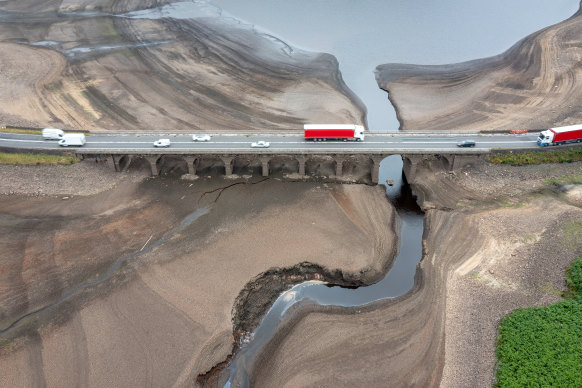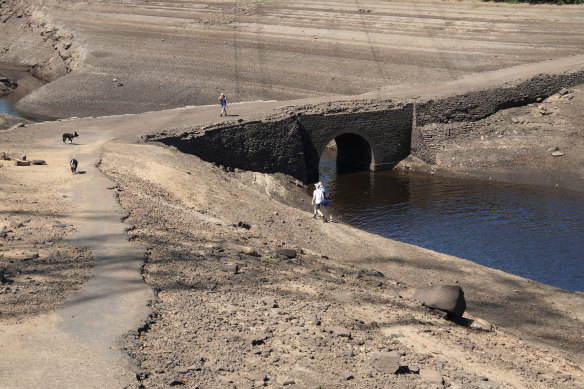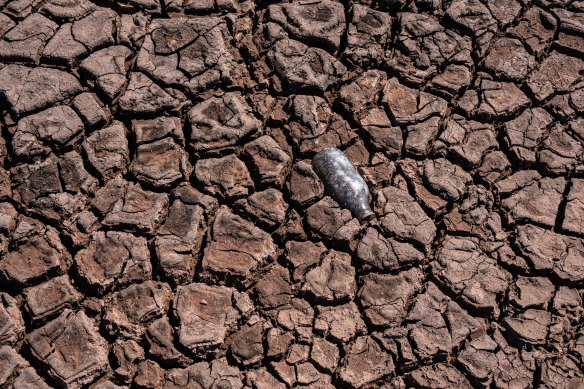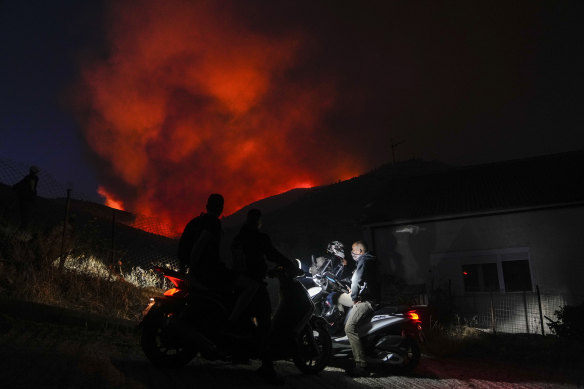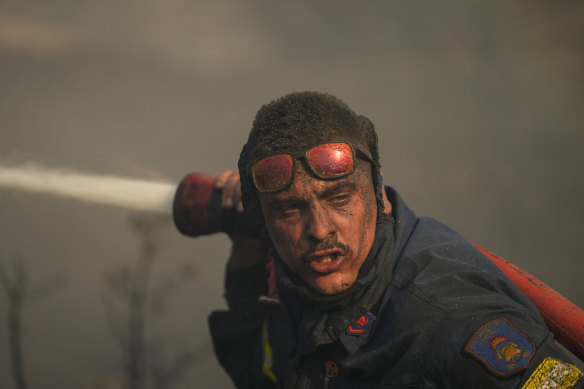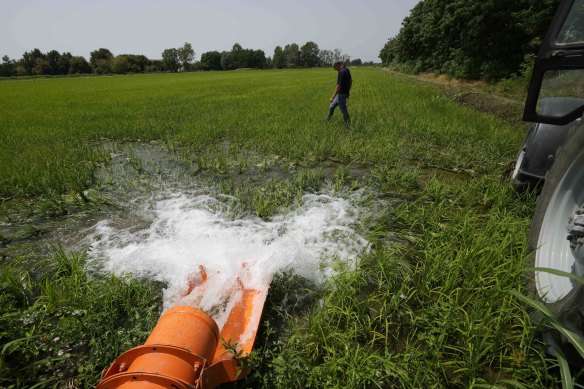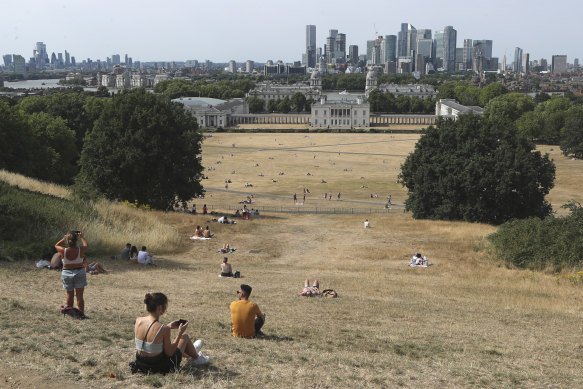London: The biggest drought in more than 20 years has been declared across the majority of England, with households warned their taps could run dry, farmers flagging major food shortages after failed crops and some supermarkets begin rationing bottled water.
Drought status was confirmed for eight of England’s 14 areas, spanning the south, east, southwest and centre of the country on Friday, as the United Kingdom experienced its driest summer for 50 years. Much of England has had little or no rain for almost 150 days.
A reservoir in Glossop, England. Credit:Getty
The prolonged dry-spell and extremely high temperatures are affecting households, industry, transport and tourism across Europe, as well as farming and agriculture. The tinder-dry ground has also provided ideal conditions for the wildfires that have ravaged France, Portugal and other countries.
Temperatures of up to 35 degrees are forecast for the weekend in Britain, after the mercury topped 40 last month for the first time in the UK since records began.
The situation is once again threatening Europe’s energy systems, adding to the gas crisis and exploding power prices which have stemmed from Russia’s invasion of Ukraine. In western Europe, hydropower output dropped 20 percent in the second quarter of this year compared to the average, with low river and lake levels starving plants.
The situation is particularly dire in Italy, where top utility Enel has had to shut “many” of its sites, while Norway may curb power exports to Europe after the government — under pressure from high energy prices — decided to prioritise replenishing parched reservoirs over generating electricity.
Low water levels at Baitings Reservoir reveal an ancient pack horse bridge as drought conditions continue in the heatwave on August in Ripponden, United Kingdom. Credit:Getty
France’s state-controlled nuclear giant EDF has also been forced to curb nuclear production after river temperatures rose and caused major disruption to cooling systems for plants. In Switzerland, one of the country’s three nuclear plants had to slash its output.
French prime minister Élisabeth Borne has activated a government crisis unit to tackle what she said was the worst drought in the country’s history by conserving water supplies and enforcing restrictions on use.
“The exceptional drought we have now has deprived numerous communities of water supplies and is a tragedy for our farmers, our ecosystems and for biodiversity,” her office said in a statement on Friday.
“Faced with this historic situation, the prime minister has decided to activate the inter-ministerial crisis unit and calls on everyone to conserve our water resources.”
A bottle sits in dried mud on the shore of the Beacons Reservoir as it lies low during the current heat wave in Merthyr Tydfil, Wales.Credit:Getty
In Germany, the levels of the Rhine River, which is used to ship everything from fuels to chemicals, paper products to grains, fell to a new low on Friday, which has further restricted the distribution of coal, petrol, wheat and other commodities amid a looming energy crisis.
The water level at Kaub near Frankfurt, a key waypoint where the fairway is shallower than elsewhere on the river, was forecast to fall below 40 cm, the level at which it is no longer economical for many barges to transit the river.
The river crisis is especially concerning for landlocked countries in central and eastern Europe that normally get fuel via the Rhine, according to the International Energy Agency.
“We’re expecting this situation to continue towards the end of the year,” Toril Bosoni, head of the IEA’s oil market division, said in a Bloomberg Television interview on Thursday.
Men on motorcycles watch a fire at Penteli, Greece in July.Credit:AP
The Italian government declared a state of emergency in five regions in early July because of a drought, which its environment agencies have cited as the worst in 70 years.
Around a third of Italy’s population, around 17 million people, as well as more than half of the nation’s pigs and cattle live around the Po, the nation’s longest river, where the waters level are now one-tenth of the annual average.
Risotto rice production in the Po River valley is under severe threat as paddy fields turn bone dry and become toxically salty.
“There are two categories of causes for this water crisis: One is the rainfall deficit of the last three years. The general rise in temperatures is also contributing; there is no doubt that climate change is having an effect,” outgoing Prime Minister Mario Draghi said last month.
A firefighter sprays water at a fire on the mount of Penteli in Greece in July.Credit:AP
Brussels has estimated that drought-related damage would cost the EU about €9 billon per year, (AU$12.9 billion) soaring to an annual €40bn if global warming was to reach 3 degrees.
Temperatures have already increased by at least 1.1 degrees since pre-industrial times, according to scientists.
Climate change is expected to increase the risk of droughts in many vulnerable regions of the world, particularly those with rapid population growth, vulnerable populations and challenges with food security, a United Nations report Drought in numbers, forecast last month.
Within the next few decades, 129 countries will experience an increase in drought – 23 primarily due to population growth and 38 because of their interaction between climate change and population growth.
A rice farmer walks on a rice field in Italy’s Po valley as the dewatering pump gets water from a channel to a dried rice field.Credit:AP
The Netherlands last week declared a national water shortage while authorities in Poland have introduced restrictions on rivers, including the country’s longest, the Vistula, where levels are at record lows. In Warsaw, ferry services across the river were suspended for a week last month because of the low level of the water.
In London, a supermarket imposed a limit on customers buying multipacks of bottled water after an official drought was declared. The Aldi supermarket in Haringey put up signs telling customers they could only purchase five single water bottles each, while the limit for multipacks was three per person.
The signs said the policy was “due to high demand” in hot weather, adding: “Limits are necessary for supporting you and your neighbours to find the products you need”.
Experts say only “exceptional rainfall” in the south and east of England over the autumn and winter would ensure that water resources returned to normal before 2023, meaning restrictions could last into next year.
People sit on the sun-parched grass in Greenwich Park.Credit:AP
“The autumn-winter period as a whole will be critical to dictating what the water resources position will be as we go into 2023,” Jamie Hannaford, a hydrologist at the UK Centre for Ecology and Hydrology, said.
Britain’s Environment Agency said the total stock of water in England’s reservoirs at the end of July was 65 per cent of its normal capacity – the lowest level for that point in the calendar year since 1995.
Environment Minister Steve Double said parts of the nation had experienced the driest July on record.
“All water companies have reassured us that essential supplies are still safe, and we have made it clear it is their duty to maintain those supplies,” he said.
“We are better prepared than ever before for periods of dry weather, but we will continue to closely monitor the situation, including impacts on farmers and the environment, and take further action as needed.”
Get a note directly from our foreign correspondents on what’s making headlines around the world. Sign up for the weekly What in the World newsletter here.
Most Viewed in World
From our partners
Source: Read Full Article
